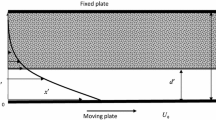Abstract
The present analysis relates to the study of the full two-dimensional Brinkman equation representing the fluid flow through porous medium. The steady, incompressible fluid flow, with a negligible gravitational force, is constrained to flow in an infinitely long channel in which the height assumes a series of piecewise constant values. The control volume method is used to solve the Brinkman equation which involves the parameter, α=α/Da, where Da is the Darcy number and α is the ratio of the fluid viscosity μf to the effective viscosity \(\tilde \mu \). An analytical study in the fully developed section of the composite channel is presented when the channel is of constant height and composed of several layers of porous media, each of uniform porosity. In the fully developed flow regime the analytical and numerical solutions are graphically indistinguishable. A geometrical configuration involving several discontinuities of channel height, and where the entry and exit sections are layered, is considered and the effect of different permeabilities is demonstrated. Further, numerical investigations are performed to evaluate the behaviour of fluid flow through regions which mathematically model some geological structures of various sizes, positions and permeability, for example a fault or a fracture, where the outlet channel is offset at different levels. The effect on the overall pressure gradient is also considered.
Similar content being viewed by others
References
Al-Hadhrami, A. K., Elliot, L., Ingham, D. B. and Wen, X.: 2000, Analytical solutions of fluid flows through composite channels, J. Porous Media. Accepted for publication.
Beavers, G. S. and Joseph, D. D.: 1967, Boundary conditions at a naturally permeable wall, J. Fluid Mech. 13, 197-207.
Brinkman, H. C.: 1947, A calculation of the viscous force exerted by a flowing fluid on a dense swarm particles, Appl. Sci. Res. A 1, 27-34.
Brinkman, H. C.: 1947b, On the permeability of media consisting of closely packed particles, Appl. Sci. Res. A 1, 81-86.
Clennell, B.: 1997, Fluid Flow Transients in the Petrophysical Characterisation of Reservoir Rocks, Internal report for Rock Deformation Research, Dept. of Earth Sciences, University of Leeds.
Kuznetsov, A. V.: 1999, Forced convection heat teansfer in a parallel-plate channel with a porous core, Appl. Mech. Engng. 4, 271-290.
Kuznetsov, A. V. and Xiong, M.: 1999, On the limitations of the single-domain approach for computation of convection in composite channels-Comparisons with exact solutions, Hybrid Meth. Engng. 1, 249-264.
Lesnic, D., Elliott, L., Ingham, D. B., Clennell, B. and Knipe, R. J.: 1998, An inverse problem to determine the piecewise homogeneous hydraulic conductivity within rocks, Faulting, Fault Seal. Fluid Flow Hydrocar. Reserv. 147, 261-268.
Nield, D. A.: 1991, The limitations of the Brinkman-Forchheimer equation in modelling flow in a saturated porous medium and at an interface, Int. J. Heat Fluid Flow 12, 269-272.
Ochoa-Tapia, J. A. and Whitaker, S.: 1995, Momentum transfer at the boundary between a porous medium and a homogeneous fluid-I. Theoretical development, Int. J. Heat Mass Tran. 38, 2635-2646.
Ochoa-Tapia, J. A. and Whitaker, S.: 1995b, Momentum transfer at the boundary between a porous medium and a homogeneous fluid-II. Comparison with experiment, Int. J. Heat Mass Tran. 38, 2646-2655.
Patanker, V.: Numerical Heat Transfer and Fluid Flow, 1980, Hemisphere, New York.
Peyret, R. and Taylor, T. D.: 1983, Computational Methods for Fluid Flow, Springer-Verlag.
Plumb, O. A. and Whitaker, S.: 1988, Dispersion in heterogeneous porous media: local volume averaging and large-scale averaging, Water Resour. Res. 24(7), 913-926.
Quintard, M. and Whitaker, S.: 1988, Two-phase flow in a heterogeneous porous media: The method of large-scale averaging, Transport in Porous Media 3(4), 357-413.
Scheidegger, A. E.: 1974, The Physics of Flow through Porous Media, University of Toronto Press, Toronto.
Vafai, K. and Kim, S. J.: 1990, Fluid mechanics of the interface region between a porous medium and a fluid layer-An exact solution, Int. J. Heat Fluid Flow 11, 254-256.
Author information
Authors and Affiliations
Rights and permissions
About this article
Cite this article
Al-Hadhrami, A.K., Elliott, L., Ingham, D.B. et al. Fluid Flows Through Two-Dimensional Channels of Composite Materials. Transport in Porous Media 45, 281–300 (2001). https://doi.org/10.1023/A:1012084706715
Issue Date:
DOI: https://doi.org/10.1023/A:1012084706715




